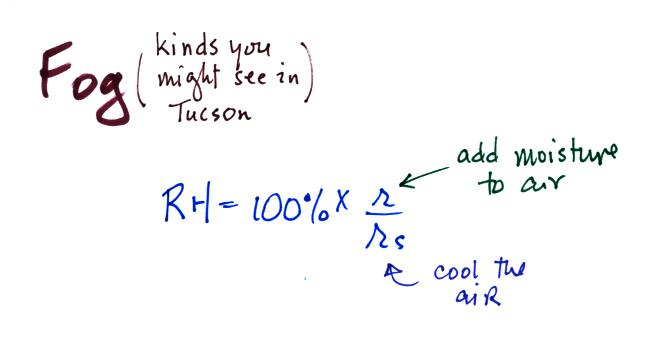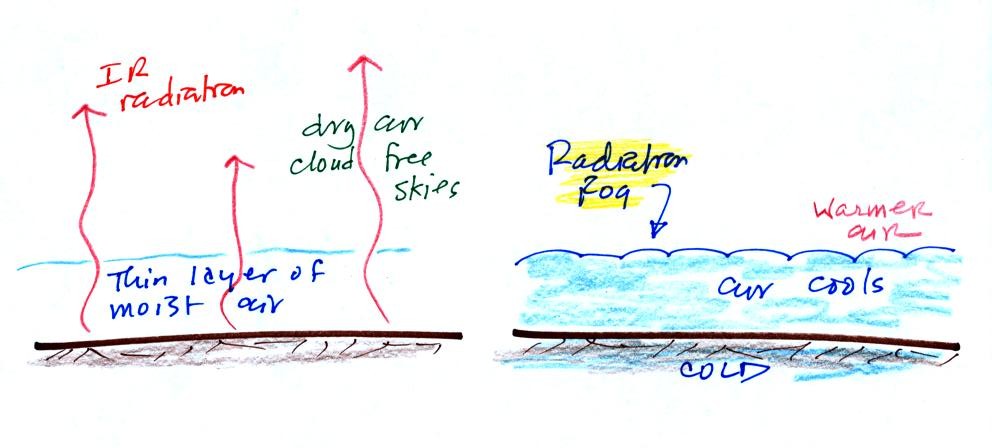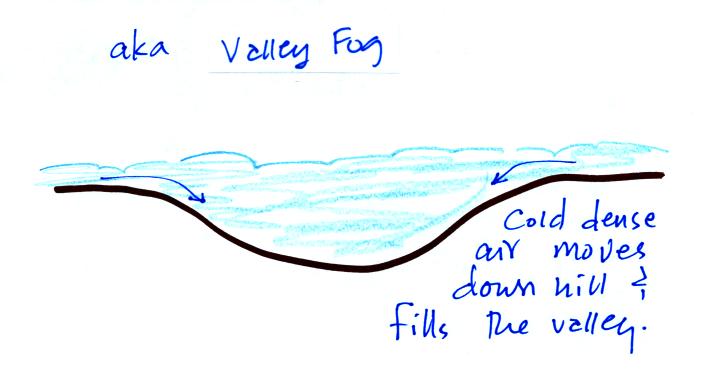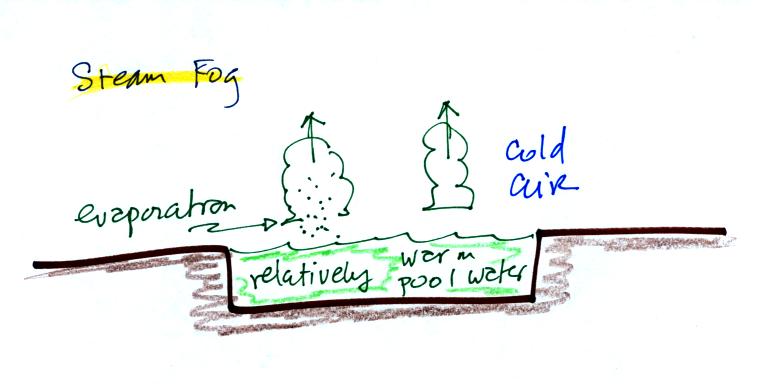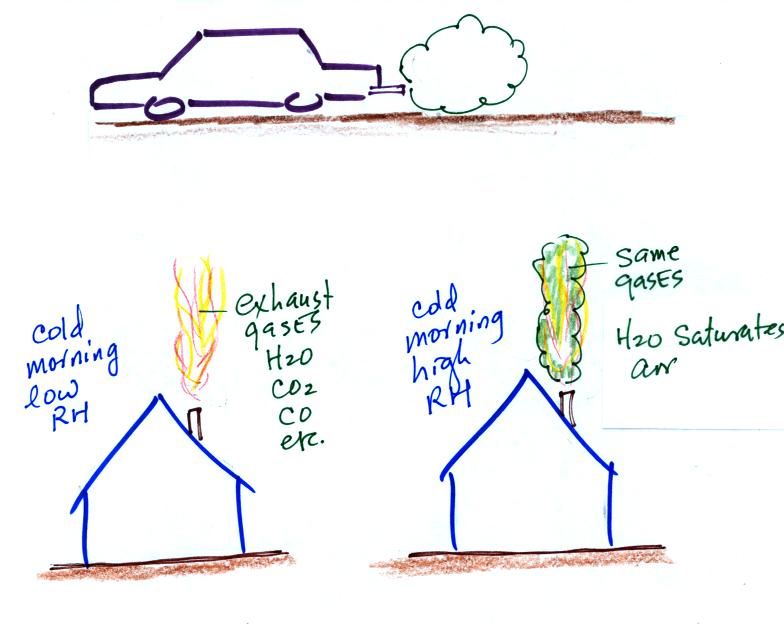Friday Oct. 22, 2010
click here to download today's notes in a more
printer friendly format
Music and video before class today featuring Andrea Bocelli and
Elisa ("La Voce
del Silencio" and "Dancing")
The Experiment #2 reports have been graded and were returned in
class today. You can revise your report if you want to; the
revised reports are due on or before Friday, Nov. 5. Please
return your original report with the revised report.
Experiment #4 materials were distributed
today. You can pick up your materials on Monday if you didn't
today.
Here's Topic #1, the
first of 10 that we covered today.
At bottom left in the figure above a 40 F
day with 30 MPH winds will feel colder (because of
increased transport of energy from your body by convection) than a 40 F
day
with no wind. The wind chill
temperature tells you how much colder it will feel.
Evaporative cooling (upper right) will make you feel cold if
you get
out of a swimming pool on an 80 F day with dry air. You won't
feel as cold if the air is humid. Sling
psychrometers make use of this to
measure relative humidity and
dew point.
Your body tries to stay cool by perspiring. You
would still feel
hot on
a hot dry day. The heat index
measures how much hotter you'd feel on a hot humid day. The
combination of heat and high humidity is a serious weather hazard
because it can cause heatstroke
(hyperthermia). Your sweat won't evaporate
as quickly on a humid day and your body might not be able to keep
itself cool.
Topic #2 Cloud
condensation nuclei can be found at the top of p. 91 in the photocopied
classnotes.
When the
relative humidity in air above the ground (and away from objects on the
ground) reaches 100%, water vapor will condense onto small particles
called condensation nuclei. It would be much harder for the water
vapor to just condense and form small droplets of pure water (you can
learn why that is so by reading the
top
of
p. 92 in the
photocopied class notes).
Water vapor will condense onto
certain kinds of condensation
nuclei
even when the relative humidity is below 100% (again you will find some
explanation of this on the bottom of p. 92).
These
are
called
hygroscopic
nuclei. Salt is an example; small particles of salt
come from evaporating drops of ocean water.
Topic #3 was a short
(homemade) video that showed how water vapor would, over time,
preferentially
condense onto small grains of salt rather than small spheres of
glass. The
figure
below
wasn't
shown
in
class.
The start of the video at left
showed the small grains
of
salt were
placed on a platform in a petri dish
containing water. Some small spheres of glass were placed in the
same
dish. After about 1 hour small drops of water had formed around
each
of the grains of salt but not the glass grains (shown above at
right).
In
humid parts of the US, water will condense onto the grains of
salt
in a salt shaker causing them to stick together. Grains of rice
apparently absorb moisture which keeps this from happening and allows
the salt to flow
freely out of the shaker when needed.
The
following figure (at the bottom of p. 91) was Topic #4.
This figure shows
how
cloud
condensation nuclei and increasing relative humidity can affect the
appearance of the sky and the visibility.
The air in the left most figure is relatively dry. Even
though
the condensation nuclei particles are too small to be seen with the
human eye you can tell they are there because they scatter
sunlight. When you look at the sky you see the deep blue color
caused by scattering of sunlight by air molecules mixed together with
some white
sunlight scattered by the condensation nuclei. This changes
the color of the sky from a deep blue to a bluish white
color. The more particles there are the whiter the sky
becomes. This is called "dry haze."
The middle picture shows what happens when you drive from the dry
southwestern part of the US into the humid
southeastern US. One of the first things you would notice is the
hazier
appearance of the air and a decrease in visibility. Because the
relative humidity is high,
water vapor begins to condense onto some of the condensation nuclei
particles (the hygroscopic nuclei) in the air and forms small water
droplets. The water droplets scatter more sunlight than just
small particles alone. The increase in the amount of scattered
light is what gives the air its hazier appearance. This is called "wet
haze."
Finally when the relative humidity increases to 100% fog
forms.
Fog can cause a severe drop in the visibility. The thickest fog
forms in dirty air that contains lots of condensation nuclei. We
will see this effect in the cloud-in-a-bottle demonstration coming up
at the end of class.
Fog is a relatively rare event in Tucson. To produce fog you
first need to
increase the relative humidity (RH) to
100%
You can do this either by cooling the air (radiation fog) or
adding
moisture to
and saturating the air (evaporation or steam fog). Both will
increase the ratio in the RH formula
above.
Topic #5 explains how radiation
fog forms. Radiation fog is probably the most common type of fog
in Tucson.
The ground cools during the night by emitting IR radiation (left figure
below). The ground cools most rapidly and gets coldest when the
skies are free of
clouds and the air is dry (except for a thin layer next to the
ground.
Air in contact with the ground cools and radiation fog can form
(right
figure above). The fog cloud is cold dense air and "hugs" the
ground.
Radiation fog is sometimes called valley fog.
The cold dense foggy air will move downhill and fill low lying
areas. Because the fog reflects sunlight, it is often
difficult for the sun to warm the air
and dissipate thick clouds of valley fog.
Topic #6 dealt with steam fog
or evaporation fog (also sometimes known as mixing fog). This is
commonly observed on
cold mornings over the relatively warm water in a swimming pool.
Water evaporating from the pool
saturates the cold air above. Because the fog cloud is warmer
than the cold surrounding air, the fog clouds float upward.
It's the same idea when you "see your breath" on a cold day
Warm moist air from your mouth mixes
with the colder air outside. The mixture is saturated and a fog
cloud forms.
The
following two figures weren't shown in class.
You might remember the following two reactions from earlier in the
semester when we were talking about photosynthesis and combustion

Combustion sometimes adds enough
water vapor to the air to saturate the air. Clouds form in that
case. Here are a couple of examples
There is enough water vapor in automobile exhause to saturate the
air and form a cloud (of course the cloud coming from the exhaust pipe
is burning oil or something like that). Exhaust from a house
furnace or hot water heat contains water vapor. When the relative
humidity is high you'll frequently see a cloud coming from one of the
vents pipes on the house roof. People will sometimes mistake this
for smoke and will call the fire department.
Topic #7
was a demonstration, the cloud in a bottle demonstration.
Cooling
air, changing relative humidity, condensation nuclei, and scattering of
light are all involved in this demonstration.


The demonstration was repeated an
additional time with one
small
change. A burning match was dropped into the
bottle. The smoke from the match added lots of very small
particles, condensation nuclei, to the air in the flask. The
cloud that formed
this time was quite a bit "thicker" and much easier to see.
Topic #8 Clouds are one of
the best ways of cleaning the atmosphere
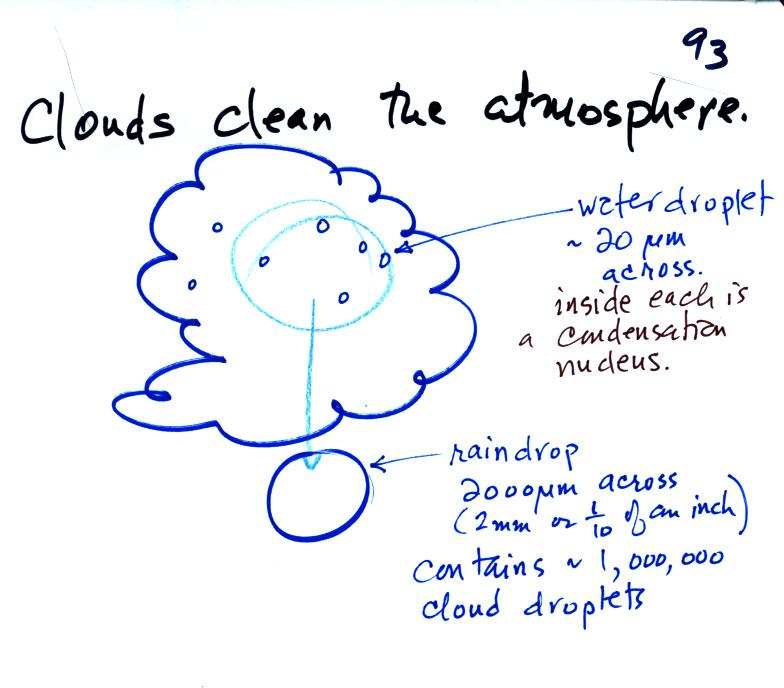
Topic #9 consisted of two small
plastic petri dishes that were passed around class. One contained
granulated sugar, the other powdered sugar. You were supposed to
look at them and determine which one look whitest. I'll see if I
can't take a photograph of them and insert the picture into the class
notes. This difference in appearance is related to the next and
last topic of the day.
Topic #10 Clouds, condensation
nuclei, and global warming

This is has implications for climate change.
Combustion of fossil fuels adds carbon dioxide to the atmosphere.
There is concern that increasing carbon dioxide concentrations will
enhance the greenhouse effect and cause global warming.
Combustion also adds condensation nuclei to the atmosphere (just like
the burning match added smoke to the air in the flask). More
condensation nuclei might make it easier for clouds to form, might make
the clouds more reflective, and might cause cooling. There is
still quite a bit of uncertainty about how clouds might change and how
this
might affect climate (remember too that clouds are good absorbers of IR
radiation).





